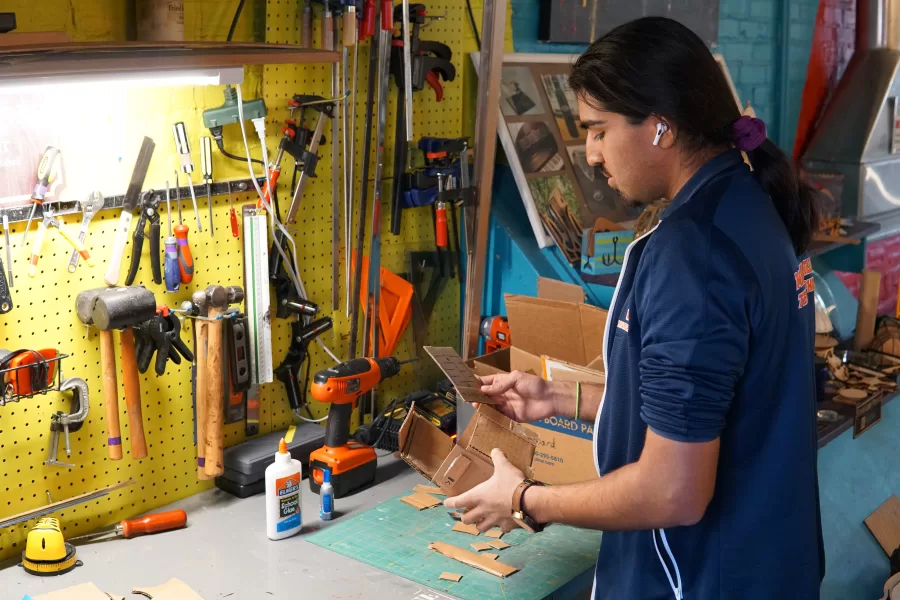C-U Fab Lab: Where art meets technology
Amaan Mirza, senior in Engineering, constructs a cardboard prototype for his INFO 418: Makerspace: Escape Rooms class offered through the University to make hands on projects in the CU Fab Lab. The University also offers various other courses through the Fab Lab.
February 9, 2023
Hidden on the South Quad is a studio where you can make your creative dreams a reality: The Champaign-Urbana Community Fab Lab, a makerspace dedicated to students and community members.
A makerspace is an open, collaborative workspace that offers tools and materials to aid users in fabricating their ideas.
The C-U Fab Lab opened in October 2009 after about a year of planning from the original team. It is currently run by a team of University members, community members and volunteers from the area. The lab has partnerships with all of the local middle schools, the Urbana Free Library, the Urbana Neighborhood Connections Center and Illinois Extension.
Kyungwon Koh, director and associate professor at the School of Information Sciences, is the lab’s director.
“It’s a makerspace within higher education that reaches out to both on- and off-campus communities,” Koh said. “They have access to some very expensive tools (that) can cost $20,000.”
Get The Daily Illini in your inbox!
Makerspaces are usually located within schools, libraries and community centers. They’re open to all people with different interests, skills and backgrounds. Makerspaces are usually open to the public, which means that anyone can go in and work on anything that they’d like to at the moment.
Fab Lab staff are also available to provide guidance.
“People who come in always have cool ideas,” said Mark Hayek, junior in Engineering, who works as a lab assistant at the lab. “I think it’s fun to brainstorm with them to figure out how to make it.”
The Fab Lab is also known for its unique summer camps that create accessible programs for those in the community.
“There are kids who haven’t seen a keyboard or mouse before, so when we do summer camps it’s a big deal,” Koh said. “There’s a huge digital literacy gap.”
Some of the popular camp offerings are the ones that involve video games like Minecraft and role playing games, or RPGs.
“You play Minecraft, scan the builds you made in Minecraft and then print them out with 3D printers,” Hayek said.
The lab also serves as a space for some University courses. Every semester, the lab offers different classes in informatics. For example, there are open studio courses and some that focus on game design and coding.
Nikita Agarwal, graduate student studying information sciences, found the lab through a course she took, INFO 415: Makerspace: Open Studio.
“(INFO 415) is based out of the Fab Lab, and they teach you how to use the different tools and technologies,” Agarwal said. “We could do 3D printing one week or laser cutting another week. It was fun.”
Recently, she used the lab’s services to embroider a hoodie for her brother.
“I learned how to sew in that class, and that’s something that I’ve always wanted to learn,” Agarwal said. “I feel (that as) clothes get more expensive and worse quality, it’s nice to be able to know the basics of mending clothes.”
The lab also facilitates research and advocates for youth and group learning within makerspaces.
“I spent years studying how (teenagers and children) learn actually when they play with it and make it,” Koh said. “Often, another thing that is really fascinating is that people learn within the makerspace without even knowing that they are learning.”
One goal of the lab is to make its studio as accessible as possible, available to everyone regardless of their abilities.
“There are limitations in not just the Fab Lab, but in all makerspaces and maker movements about accessibility because current technology is very visual,” Koh said. “But we see the potential for blind people, because it’s also a physical and tangible textile.”
Hayek said that the lab has had a lasting impact on him.
“Working with the Fab Lab definitely changed my worldview,” Hayek said.







